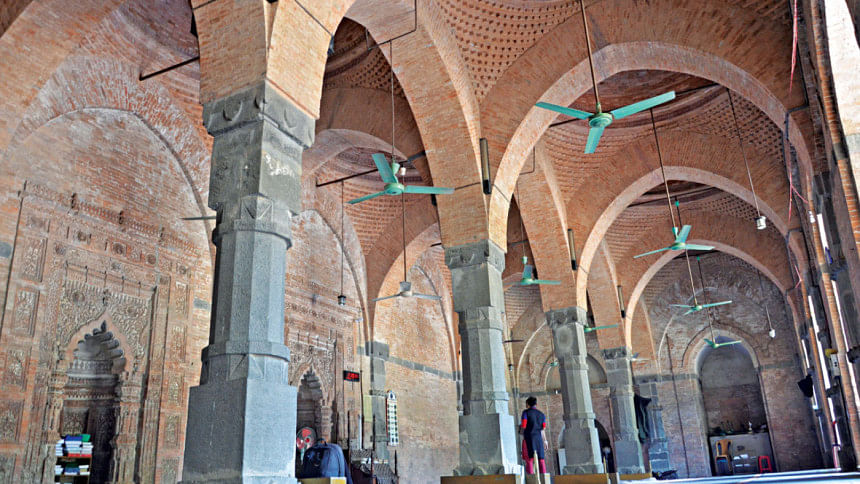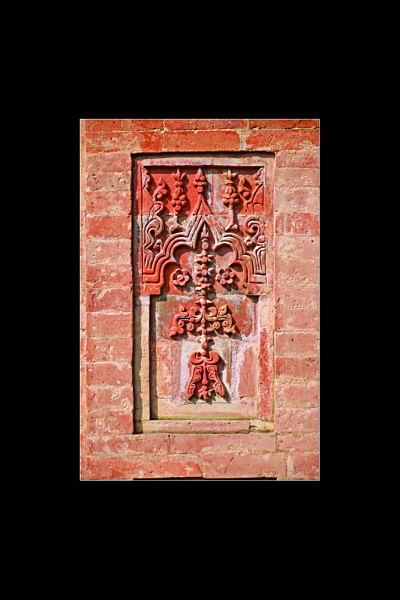The Grand Mosque of Bagha

Photos: Anwar Ali
Bagha, now a serene, small upazila town located some 40 kilometers away from Rajshahi city, was once upon a time, a thriving trading centre on the bank of mighty Padma River. One of the remnants of its glorious past has survived the wrath of time and it is considered one of the most significant and beautiful archeological sites of Bangladesh. It is the Shahi (grand) mosque of Bagha, the most beautifully decorated mosque built in the independent sultanate period of Bengal.
Surrounded by an ancient freshwater lake, beautifully landscaped orchards, ancient ruins, graveyards of the saints who preached Islam in this area and with a recently built museum, the mosque along with its scenic premises is an ideal place to reminisce about Bangladesh's prosperous history. Established by Nasrat Shah, the Sultan of independent Bengal, in the year of 1523-24, the mosque is well known for its depiction on the banknote of fifty taka.
Built on a stone-carved pedestal measuring around 8-10 feet high, it's a rectangular structure with four decorated corner turrets. The structure is seventy five feet in length, forty two feet in width and twenty four feet in height. There are 5 beautifully decorated twelve feet high archways which not only serve as the entrances, but also ensure superb ventilation in the mosque. There are ten semicircular domes on the arched roof supported by six pillars made of black basalt stone.

The mosque is famous for its magnificent terracotta ornamentation. The entire mosque wall- both interior and exterior is covered with elaborate depiction of exquisite floral patterns, abstract fretwork and geometric patterns. There are four decorated mihrabs (prayer niche) in the mosque which are considered the epitomes of Islamic terracotta ornamentation. There are also Arabic and Persian calligraphic inscriptions attached to the interior and exterior walls of the mosque.
Another similar but smaller three domed structure can be found a few yards away from the Shahi mosque, which was built for the women worshippers of the noble families. This special mosque for women is locally called the "mosque of the stolen plaque". The caretaker of the mosque says, "The calligraphic inscription on the black-stone plaque which you can see attached to the exterior wall was stolen by some robbers during the 90s. They sold the plaque to a curio shop in Delhi, India. However, the curse of Allah fell upon them and they suffered a lot. Then, the same robbers, who had stolen the plaque, bought it back and returned it to the mosque."
Despite of its historical significance, signs of negligence in preserving this mosque is quite eminent. During the earthquake of 1897, a part of the mosque collapsed which was repaired in accordance with the actual design during the late 70s. Since then, no steps have been taken for further maintenance in the last thirty five years. Many of the decorated terracotta tiles have been fractured and a lot of the beautiful patterns, damaged. There is only one caretaker to guard and maintain the mosque and its huge premises of 256 bighas of land.
Due to its remote location, very few people are actually concerned about the maintenance of this significant and beautiful heritage site. The mosque and its picturesque premises will be able to attract a lot of tourists and history enthusiasts from home and abroad if proper maintenance is ensured.


 For all latest news, follow The Daily Star's Google News channel.
For all latest news, follow The Daily Star's Google News channel. 



Comments